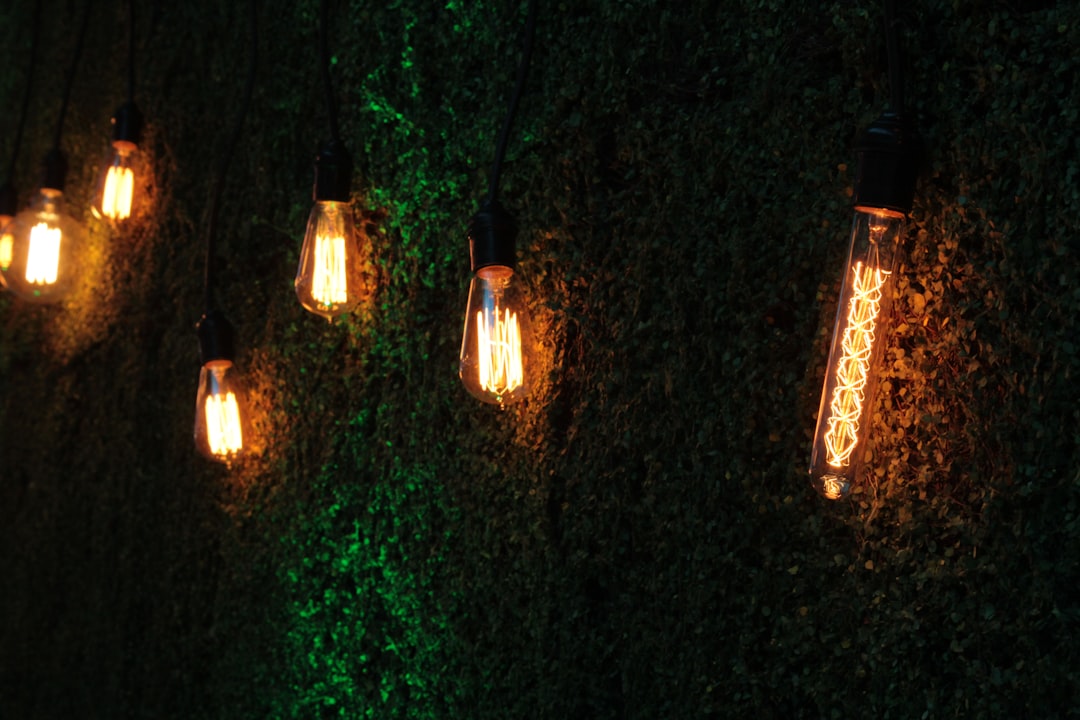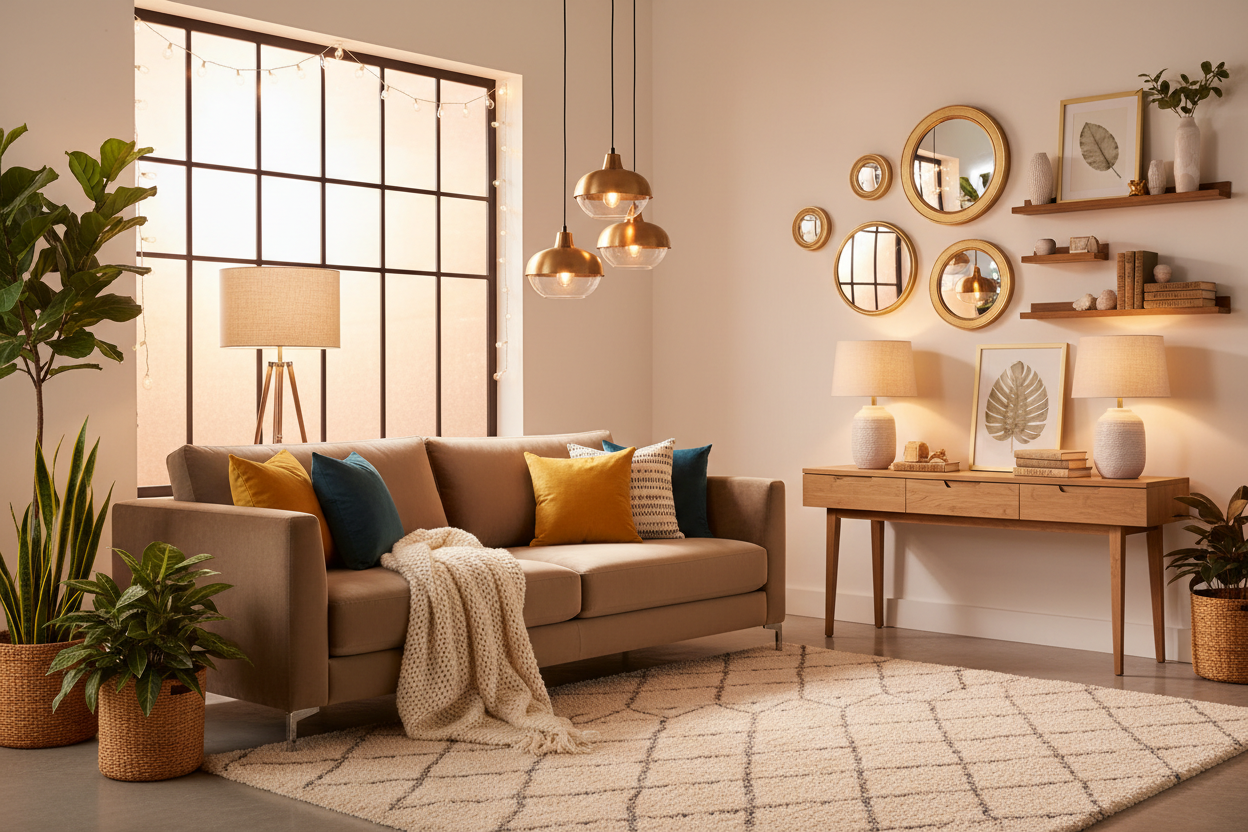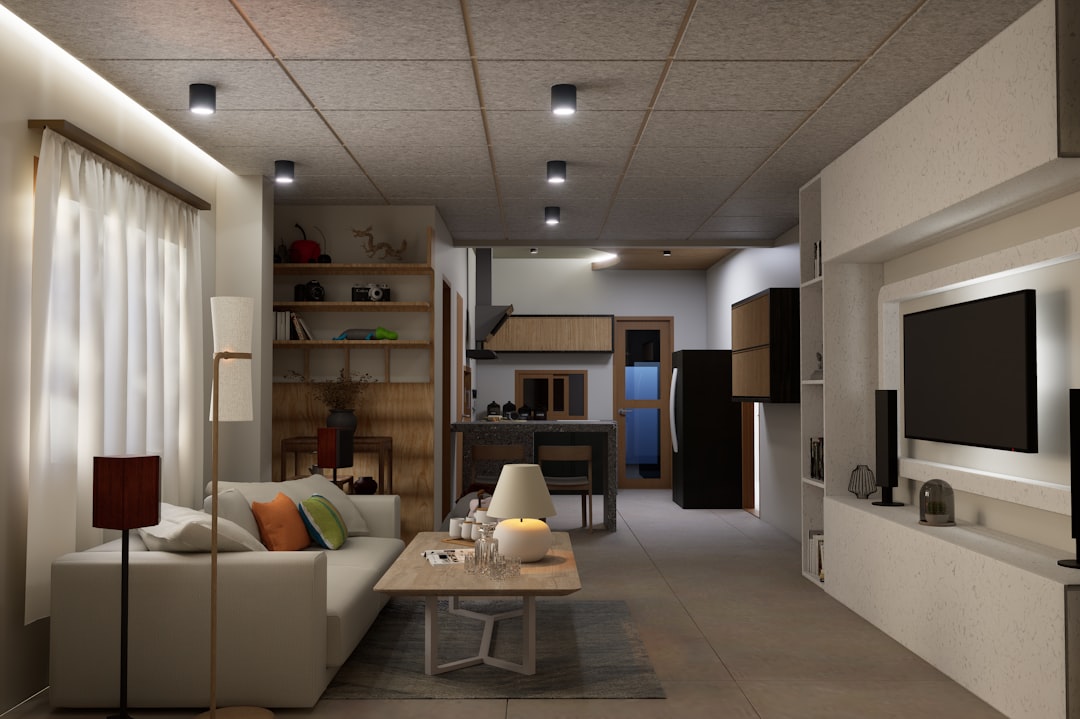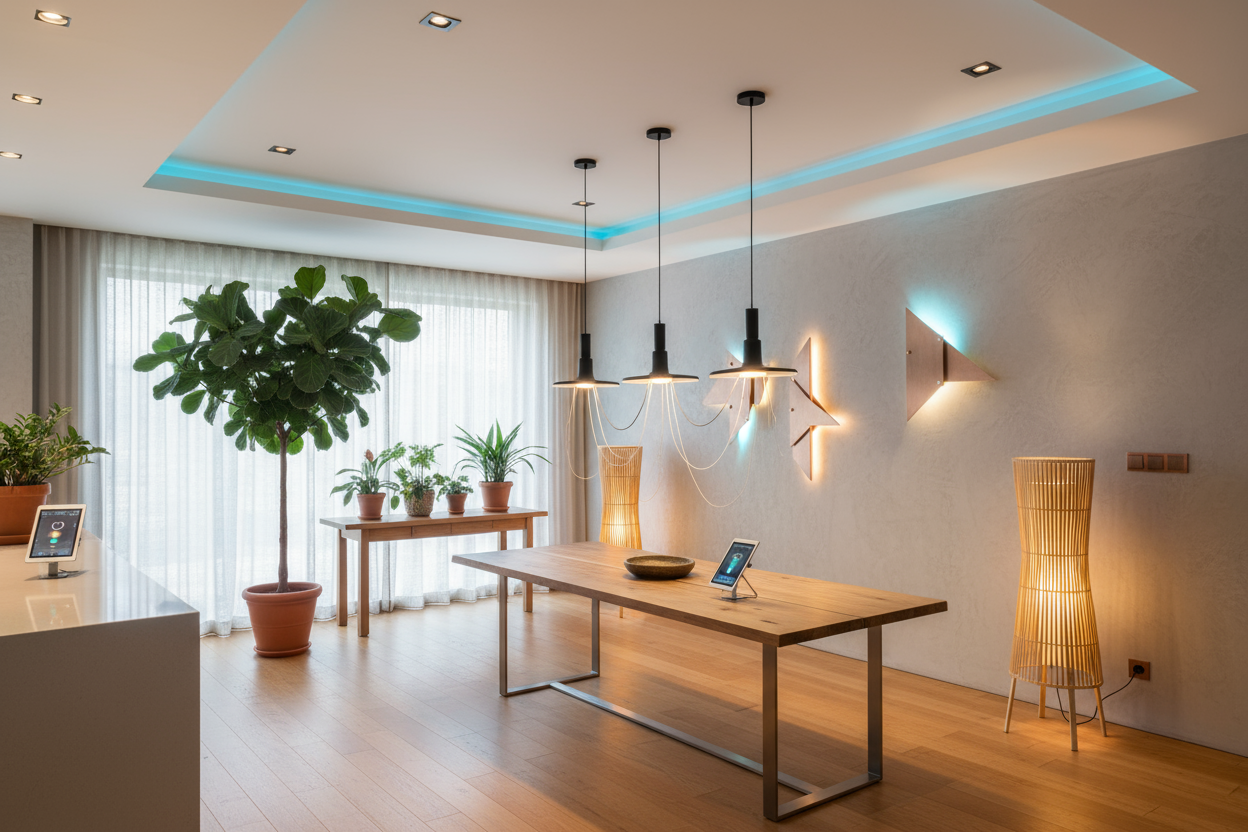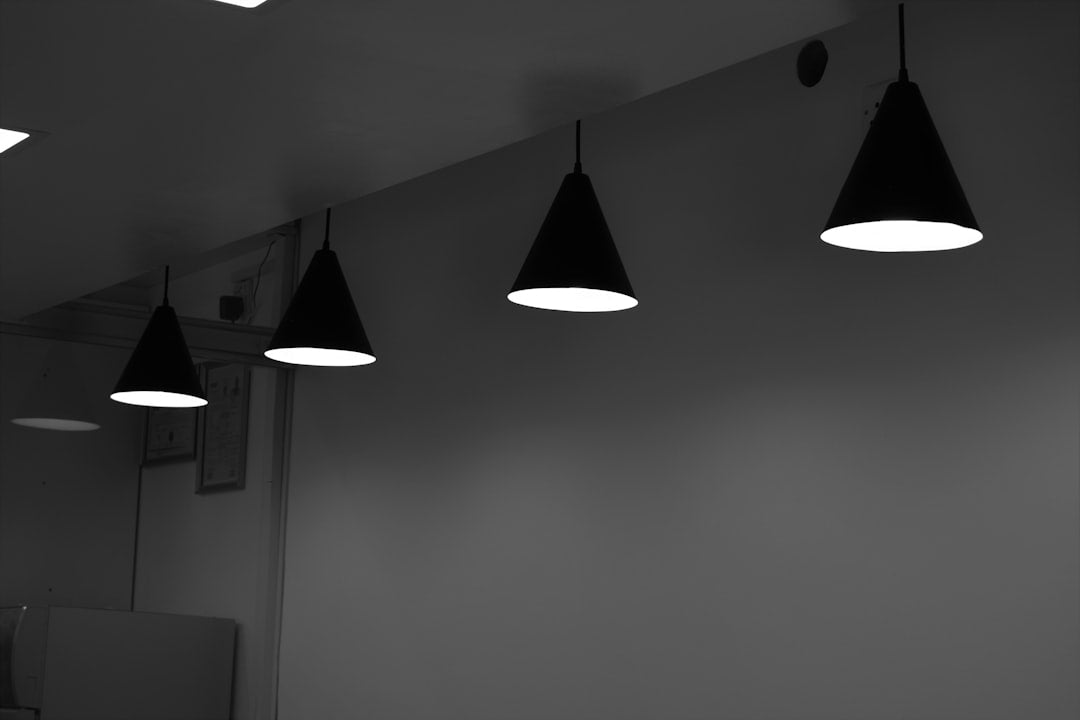Choosing the Perfect Lighting Solutions for Every Room in Your Home
Lighting shapes more than just brightness — it influences atmosphere, functionality, and well-being. Discover how tailored lighting solutions for each room can transform your house into a harmonious, beautiful home.
Key Takeaways
- Layered lighting combines ambient, task, and accent lights to create balance and flexibility.
- Color temperature matters: warm tones suit relaxing spaces, cooler lights enhance focus and clarity.
- Maximize natural daylight for health and energy savings.
- Energy-efficient LED technology reduces power consumption and maintenance.
- Smart and adaptive lighting systems improve comfort through seasonal and task-based adjustments.
Table of Contents
- 1. Understanding Layered Lighting
- 2. Lighting Solutions for Living Rooms
- 3. Kitchen Lighting
- 4. Bedroom Lighting
- 5. Bathroom Lighting
- 6. Home Office Lighting
- 7. Maximizing Natural Light
- 8. Energy-Efficient LED Lighting
- 9. Outdoor Lighting
- 10. Adapting Lighting for Seasonal Changes
- 11. Final Thoughts
1. Understanding Layered Lighting: The Foundation of Great Room Lighting
Mastering layered lighting is the key to versatile and beautiful room illumination. It combines three foundational layers:
- Ambient Lighting: General illumination from chandeliers, ceiling lights, or recessed fixtures that brighten the overall space.
- Task Lighting: Focused lights such as desk lamps or under-cabinet strips that make activities like reading or cooking easier.
- Accent Lighting: Decorative elements like wall sconces or track lights that highlight artwork or architectural details.
Effective layering allows a room to adapt to different moods and uses, adds depth and dimension, and supports daily rhythms.
"Layered lighting lets you flow from bright and functional to soft and atmospheric seamlessly."
Learn more about layering techniques in this guide on the art of layered lighting and from Decorilla’s overview.
2. Lighting Solutions for Living Rooms: Versatile and Inviting
The living room is your social and relaxation hub. Its lighting must be flexible, warm, and welcoming.
- Ambient: Chandeliers, pendants, or recessed lights for soft, even coverage.
- Task: Floor and table lamps near seating areas for focused reading light.
- Accent: Wall sconces, track lights, or LED strips to highlight art or architectural features.
Color Temperature: Warm white bulbs (2700K–3000K) foster coziness and calm.
Pro Tips:
- Incorporate dimmers for instant mood adjustment.
- Avoid harsh lighting near seating by placing lamps thoughtfully.
- Use layered lighting to transition from lively social spaces to tranquil retreats.
Elevate your living space further with this guide to layering home lighting.
3. Kitchen Lighting: Bright and Practical for Efficiency
A clear, focused kitchen lighting scheme is essential for safety and ease.
- Ambient: LED panels or flush mounts provide uniform brightness.
- Task: Under-cabinet strips and pendants illuminate work surfaces exactly where needed.
- Accent: Cabinet or shelf lighting adds charm and depth.
Color Temperature: Cooler white tones (4000K–5000K) for clarity and alertness.
- Choose high-performance LEDs for longevity and energy saving.
- Keep kitchens cool — LED lights emit less heat.
- Use adjustable dimmers to shift ambiance from cooking to dining.
Explore kitchen lighting options at Jarvis Lighting.
4. Bedroom Lighting: Creating a Calming Retreat
Bedrooms should feel like peaceful sanctuaries. Soft, warm lighting helps signal rest.
- Ambient: A soft ceiling light or chandelier for general glow.
- Task: Bedside lamps or adjustable reading lights for comfortable use.
- Accent: Discreet wall sconces or LED strips for warmth.
Color Temperature: Warm 2700K lights mimic sunset tones to aid relaxation and healthy sleep.
- Dimmable fixtures allow easy adjustment without leaving bed.
- Keep switches or lamps within easy reach.
- Avoid blue-tinted or cool lighting near bedtime to preserve natural rhythms.
Discover more about bedroom lighting in this lighting design article.
5. Bathroom Lighting: Bright, Functional, and Soothing
Bathrooms require lighting that supports grooming tasks and fosters relaxation.
- Ambient: Recessed ceiling lights or flush fixtures add soft general brightness.
- Task: Vanity lighting framing mirrors to reduce shadows.
- Accent: LED niches or under-cabinet strips add subtle interest.
Color Temperature: Neutral white 3000K–4000K for accurate color and warm feel.
- Frame mirrors with lights on each side to avoid facial shadows.
- Use dimmers to switch between bright task light and relaxing ambiance.
Explore creative bathroom lighting ideas in this design guide.
6. Home Office Lighting: Enhancing Productivity and Reducing Eye Strain
A well-lit home office supports focus, reduces fatigue, and preserves eyesight.
- Ambient: Balanced overhead lighting fills the workspace.
- Task: Adjustable desk lamps target your work area without glare.
- Accent: Soft background lighting eases contrast and adds depth.
Color Temperature: Cooler whites (4000K–5000K) simulate daylight to boost alertness.
- Place desks near windows to capitalize on natural light.
- Use dimmable LEDs with adjustable color temperature for customized comfort.
- Position lamps to avoid screen reflections.
- Incorporate smart lighting to easily shift modes throughout the day.
Learn more about smart lighting and layering at Vesternet and this layered lighting resource.
7. Maximizing Natural Light in Your Home
Natural daylight improves mood, alertness, and reduces energy costs. Here’s how to make the most of it:
- Position desks and seating close to windows.
- Use sheer curtains or light-filtering blinds to soften glare.
- Consider skylights or larger windows in darker rooms.
In spaces lacking daylight, simulate natural light cycles with technologies like NatureConnect LEDs.
Discover the benefits of light exposure here.
8. Energy-Efficient LED Lighting: Save Money and the Environment
LEDs are a smart, sustainable choice offering:
- Up to 80% less energy use than traditional bulbs.
- 15 to 25 times longer lifespan, reducing waste and replacement costs.
- Compatibility with dimmers and smart controls.
- Minimal heat emission for safer, cooler spaces.
Ideal for ambient, task, and accent lighting throughout your home, LEDs pay off quickly — as proven by a condominium cutting monthly bills from $630 to $370 after a switch.
Visit Natural LED or browse options at Jarvis Lighting.
9. Outdoor Lighting: Security and Curb Appeal
Outdoor lighting enhances your home’s beauty, safety, and security:
- Bollard Lights: Illuminate walkways and driveways with stylish post lighting.
- Floodlights: Provide broad coverage ideal for security around entrances or yards.
- Garden Lights: Accent plants, trees, or sculptures beautifully.
Eco-friendly features include dusk-to-dawn sensors, solar power, and motion detection for efficient, secure illumination.
Get ideas from smart outdoor lighting guides.
10. Adapting Lighting for Seasonal Daylight Changes
To maintain comfort through shifting daylight hours, consider:
- Tunable smart lighting that adjusts brightness and color temperature automatically.
- Scheduled dimming aligned with sunrise and sunset times.
- Flexible layering of task and ambient lights to suit seasonal needs.
These strategies support mood, energy, and energy efficiency year-round.
Learn more about these systems at Vesternet smart lighting.
11. Final Thoughts: Tailored Lighting Transforms Your Home
Lighting isn’t merely functional—it’s integral to how we live, work, and relax. Thoughtful layering, proper color temperature, and integrating natural light create spaces that support every lifestyle. Coupling this with energy-efficient LEDs and smart controls ensures sustainability and comfort. Outdoor and seasonal lighting complete the experience, making your home shine brilliantly in every scenario.
For expert guidance and a wide range of stylish options, visit Lightsdaddy.
FAQ
What is layered lighting and why is it important?
Layered lighting combines ambient, task, and accent lights to create a flexible, balanced, and visually interesting space. It adapts rooms for different activities and moods, enhancing both function and atmosphere.
How do I choose the right color temperature for my rooms?
Warm white (2700K–3000K) suits relaxing areas like bedrooms and living rooms. Cooler white (4000K–5000K) is ideal for kitchens and workspaces, where clarity and focus are needed.
Can LED lighting work with dimmers and smart home systems?
Yes, most modern LEDs are compatible with dimmers and smart controls, allowing you to adjust brightness and color temperature easily, customize schedules, and save energy.
How can I maximize natural light without causing glare?
Position seating near windows, use sheer curtains or light-filtering blinds, and avoid placing screens directly facing windows to reduce glare while maintaining brightness.
What outdoor lighting options are best for security?
Motion-sensor floodlights, dusk-to-dawn LED fixtures, and well-placed path and bollard lights effectively enhance outdoor safety and deter intruders.




